Without your help, clients can rarely navigate the road to healing from gaslighting, codependency, torn attachment, narcissistic abuse, and the grief toxic relationships cause.
While you might easily recognize the signs that a client’s sense of self is shattered…
Many therapists don’t have dynamic and specific tools to help their clients overcome the debilitating damage of these relationships.
Sharpen your healing skills with easy-to-integrate interventions from the most in-demand approaches, like CBT, DBT & EMDR, to empower your clients to move their lives forward.
This comprehensive course brings together an expert panel of speakers who’ve devoted their professional careers to helping clients overcome the abuse and pain from toxic relationships. Now you can learn the skills and insight that they’ve honed through more than 100 years of combined clinical and research experience.
- Treat co-occurring anxiety, PTSD, SUDs, Personality, Mood, & more
- Restore rationale thought to clients who’ve been manipulated
- Apply insights from research on love bombing, gaslighting, & more
- Strategies for clients emerging from romantic, work, family, or other toxic relational trauma
- Guide clients through the grief of past, present, & future losses
PLUS, get THREE incredible bonus trainings that explore somatic, attachment-based and more interventions.
Be the therapist that helps their clients learn to be vulnerable again — get ready to transform your skills and your client’s lives.
Codependency, Narcissism & Trauma Bonding: CBT, DBT & EMDR Strategies to Free Clients from Toxic Relationships
Own it for Just $124.95 Today — Phenomenal Savings!
- Unlimited access to over 21 hours of expert training content
- A free eBook, downloadable worksheets, assessment tools, and client exercises
- Access to a forum to share questions and insights with like-minded clinicians
- Printable training manuals you can refer to again and again throughout your career
All while refining and expanding your concrete, in-session skill set!
What You'll Discover!
Get tailored tools for treating clients who’ve experienced traumatizing relationships — whether at work, in romance, with family members, or other places. Expand your scope of practice and help your clients rebuild their lives.

CBT, DBT & EMDR Strategies to Free Clients from Codependency, Narcissistic Abuse & Attachment Trauma – Krystal Mazzola Wood, LMFT
Get essential skills from CBT, DBT, EMDR, Mindfulness & Narrative Therapy to move your clients forward in life after toxic relationships, attachment trauma, narcissistic abuse and more. In just three self-paced modules, you’ll learn everything below:
- What codependency isn’t
- New research: narcissistic abuse, gaslighting, lovebombing
- How codependency develops in childhood & adulthood
- Trauma areas specific to codependency — bullying, rejection, social disconnection, IPV, infidelity, betrayal & addiction
Assessment and Diagnosis: Core symptoms of codependency
- Red flags of codependency: common client statements, ruminations & more
- Combat tendency to neglect, abuse, or self-sabotage
- Explore core & empowerment shame issues
- Comorbidities: SUDs, anxiety, PTSD, CPTSD, Personality & Mood Disorders
- Exploring your client’s loss of self
Dive into Problem Areas: Distorted Reality, Boundaries, Control & Relationships
- Overcome roadblocks: resentment, people pleasing, approval seeking
- Manage perfectionism, fantasy thinking & damage from gaslighting
- Improve guilt, trust, catastrophizing & polarized thinking
- Improve intimacy issues & heal fears of abandonment
- Assessment checklist & more worksheet
Roadmap for Treatment: The 4-Core Treatment Stages
Phase one: Guide Clients’ Self-Work
- Build client insight & awareness to destructive patterns
- Implement narrative therapy & journal writing prompts
- Nervous system balancing exercises: yoga, mindfulness, medication & more
- Combat shame with self-validation
- Teach clients how to practice patience
- Replace shame with self-validation
- Create internal & external boundaries in clients
- Explore 7 types of essential boundaries
- Help client’s authentic self shine
- Grief work specific to relationships
- Intervene in fight-flight-freeze response
- Diaphragmatic breathing — instructions & benefits
- Guide inner child and reparenting
- Healthy parenting education
- Guided scripts for self-visualization and inner child visualization
- Step-by-step guidance in assertiveness training
- Appropriate empathy and vulnerability
- Teach clients to accept support
- Flooding and time-outs
- Build awareness of abusive behaviors
- Interdependence — the solution to co-dependency
Phase One
- Learn self-soothing toolkit & teach mindfulness to clients
- Practice radical acceptance of self & self-validation
- Discover states of Mind
- Learn ACCEPTS
- Work with the 5 senses
- Dialectical thinking about self, others, reality
- Radical acceptance of others
- Check facts to correct distortions
- Practice “coping ahead”
- Dialectical thinking
- Radical acceptance of change
- Meaning making — IMPROVE
- DEAR MAN, THINK & other interventions
- Broken record for boundary development
EMDR, CBT & Narrative Therapy Strategies
EMDR
- Container
- Butterfly hug
- Safe place
- Negative cognitions and validity of cognition
- Thinking mistakes
- Challenge and Replace Negative Thoughts
- Response prevention plan
- Effective problem solving
- Deconstruct the socially constructed self
- Writing as therapy
- Externalize inner critic
Self of the Therapist: How Your Work Supports Therapy
- Prevent clients from entering a co-dependent relationship with you
- Examine personal experiences and biases
- Impact of pervasive codependent messages in culture
- Manage perfectionism
- Role model self-compassion & boundaries
Two case-studies
- “Savannah” codependency with comorbidity of PTSD and BPD
- “Leticia” codependency with comorbidity of anxiety

Narcissistic Abuse for Therapists: Empower Clients to Break Free and Recover from Gaslighting, Emotional Manipulation and Coercion – Amy Marlow-MaCoy, LPC
Get clients to overcome the toxic legacy of their most challenging relationships with narcissists and other abusers.
Narcissistic Personality Disorder and the Spectrum of Narcissistic Traits
- DSM-5™ criteria for Narcissistic Personality Disorder
- Social and culturally acquired definitions
- The spectrum of narcissistic traits
- Narcissistic traits without meeting criteria for NPD
- Psychoeducation for survivors about NPD, narcissistic behavior and its consequences
Narcissistic Abuse and General Emotional Abuse:
Similarities, Differences and Tactics Impacting Detection and Treatment
- Goals of perpetrators of emotional abuse vs. narcissistic abuse
- Cycle of abuse in narcissistic relationships
- Gaslighting and other tactics of manipulation and coercion
- What is narcissistic supply?
- Subtypes: engulfing and ignoring/neglecting
Narcissistic Abuse in Specific Relationships:
Dynamics and Impacts
- Romantic/intimate relationships/sex addiction
- Co-parenting vs. counter-parenting
- Friendships and frenemies
- Family of origin — the golden child, black sheep, scapegoat, and invisible child
- Lack of self-esteem, difficulties trusting others, C-PTSD and other effects of narcissistic abuse
Potential Missteps and Traps to Avoid
- Everyone’s a narcissist (over-pathologizing problematic behaviors)
- No one’s a narcissist (dismissing client reports because you can’t diagnose NPD)
- Pushing for reconciliation or family therapy
- Inadvertently gaslighting clients by questioning hard-to-spot emotional manipulation
- Not focusing enough on calming the underlying trauma triggers
Break the Cycle of Abuse through Increased Autonomy, Agency and Sense-of-Self
- Building assertiveness and individuation — strategies to help clients be their own individual
- Exercises to help clients discover their own preferences, interests, desires, and goals
- Teach clients to distinguish between assertiveness, aggression, and passive aggression
- Counteract internalized messaging that assertive communication is harmful, cold, cruel, or harsh
- Prepare clients for the backlash that often attends increasing autonomy and agency
- Cultural sensitivity considerations
- Exploring levels of contact and clients’ wishes regarding contact
- Developing healthy boundaries — how to best protect themselves within the relationship parameters they choose
- Processing guilt/shame over setting boundaries and saying no
- Coping strategies for when contact is inevitable
Additional Approaches and Considerations
- Trauma competency — an essential for working with these clients
- Inner child work to heal attachment wounds
- Is family therapy advised?
- Specific modalities to explore – AEDP, IFS, EMDR, SE, BSP, Gestalt
- Research, risks and treatment limitations

Codependence: Treatment Strategies for Clients Who Lose Themselves in Others – Nancy Johnson, LPC, LSATP, MAC, NCC
Get skills to help any client overcome codependent behaviors, thoughts, and debilitating feelings. You’ll walk away with skills to help re-orient clients to themselves, such as:
- Over-focused on caring for, fixing, controlling, pleasing, and/or conflict-avoiding
- Specific strategies for adult children of an addict
- Shift client’s focus from the external to the internal & get them talking about themselves in session
- Help clients get in touch with their suffering, instead of downplaying it
- Guidance on how to help clients in abusive relationships
- Empower clients to overcome their fears that keep them from making life changes
All in simple, non-stigmatizing language that helps clients change their lives for good!
THREE INCREDIBLE BONUS TRAININGS
Laura Copley, PhD, LPC |
Learn a therapeutic framework you can apply to help all your clients recognize the spectrum of toxic relationships, heal the wounds that create trauma bonds, and rediscover their Self. You’ll discover how to:
- Map the five stages of the trauma bonding
- Apply concrete tools to help clients reclaim and reparent the Self
- Use an experiential “cord-cutting” intervention that releases clients from toxic dynamics to open themselves to post-traumatic growth

Abi Blakeslee, SEP, CMT, MFT, PhD |
Pulling from the latest developments in Somatic Experiencing and neuroplasticity, you’ll get a dynamic toolkit of body-oriented approaches for treating early developmental trauma as well as helping clients improve nervous-system regulation to repair relationships. You’ll explore:
- The neurophysiological and embodied underpinnings of healthy relationships
- How to create a vibrant experience of resilience and wholeness in your work
- How implicit memory shapes our physiological and psychological responses to trauma and recovery
- Three skills to work with the autonomic nervous system to rebound from trauma and overwhelm

Trauma and Attachment: Over 150 Attachment-Based Interventions to Heal Trauma
by Christina Reese, PhD, LCPC |
Through a variety of worksheets, exercises, and activities, this book provides clients with the tools they need to develop a foundation for healing so they can find feelings of safety and security within relationships again.
You’ll find tools to help your clients heal from the impact of:
- Abuse by helping them establish safety and security within relationships.
- Neglect by teaching them to find their voice and express their needs.
- Medical trauma by helping them adjust to a new normal and better tolerate uncertainty.
- Natural disasters by using mindful grounding techniques to navigate sensory triggers and cultivate mind-body awareness.
- Witnessing violence by restoring clients’ sense of felt safety and helping clients identify what they can control to keep themselves safe.

Meet Your Expert Codependency Treatment Instructors

Nancy L. Johnston, MS, LPC, LSATP, MAC, NCC, is a licensed professional counselor and licensed substance abuse treatment practitioner with 46 years of clinical experience. She is a master addiction counselor and an American Mental Health Counselors Association (AMHCA) diplomate in substance abuse and co-occurring disorders. She is the author of three books, The Clinician’s Codependency Treatment Workbook; Disentangle: When You’ve Lost Your Self in Someone Else and My Life as a Border Collie: Freedom from Codependency. Nancy is a sought-after speaker and trainer, and a facilitator of Codependence Camp, a biannual retreat for people in codependence recovery.

Krystal Mazzola Wood, LMFT, is a licensed marriage and family therapist, author, and codependency expert. Krystal gained her expertise in codependency by working at The Meadows, a world-renowned treatment center. Here, Krystal trained under pioneering codependency expert Pia Mellody. Throughout this time, Krystal has been fascinated by the systems in which people suffer – and recover – from the beginning of her career. This systemic focus led her to create her five-step codependency recovery system, which is featured in her book, The Codependency Recovery Plan: A 5-Step Guide to Understand, Accept, and Break Free from the Codependent Cycle. To support readers further, she then wrote The Codependency Workbook: Simple Practices for Developing and Maintaining Your Independence.

Amy Marlow-MaCoy, LPC, focuses her practice on treating complex and developmental trauma in adults raised in narcissistic, emotionally immature, and toxic families of origin.
She is the author of the Amazon best-selling book The Gaslighting Recovery Workbook: Healing from Emotional Abuse (Callisto Media, 2020), a workbook designed to help individuals identify, understand, and begin to heal from emotional trauma and abuse caused by gaslighting in interpersonal relationships.
Amy has been trained in Level 1 Internal Family Systems therapy. She also provides supervision to LPC candidates and regularly consults with other clinicians regarding treatment of adult children of narcissists. She earned her Mast of Education in counseling psychology degree from Temple University.
Frequently Asked Questions
You’ll learn practical, ready-to-use strategies from CBT, DBT, EMDR, and other evidence-based approaches to help clients:
-
Rebuild a sense of self after toxic relationships
-
Break free from codependency and trauma bonding
-
Process grief, shame, and attachment wounds
-
Develop boundaries and healthier relationship patterns
What materials are included?
-
Over 21 hours of expert-led training videos
-
Downloadable eBook, worksheets, and assessment tools
-
Printable training manuals for long-term reference
-
Access to a private forum for discussion and peer support
Click the “Download Course” button, complete your purchase, and you’ll receive instant access to all training materials.

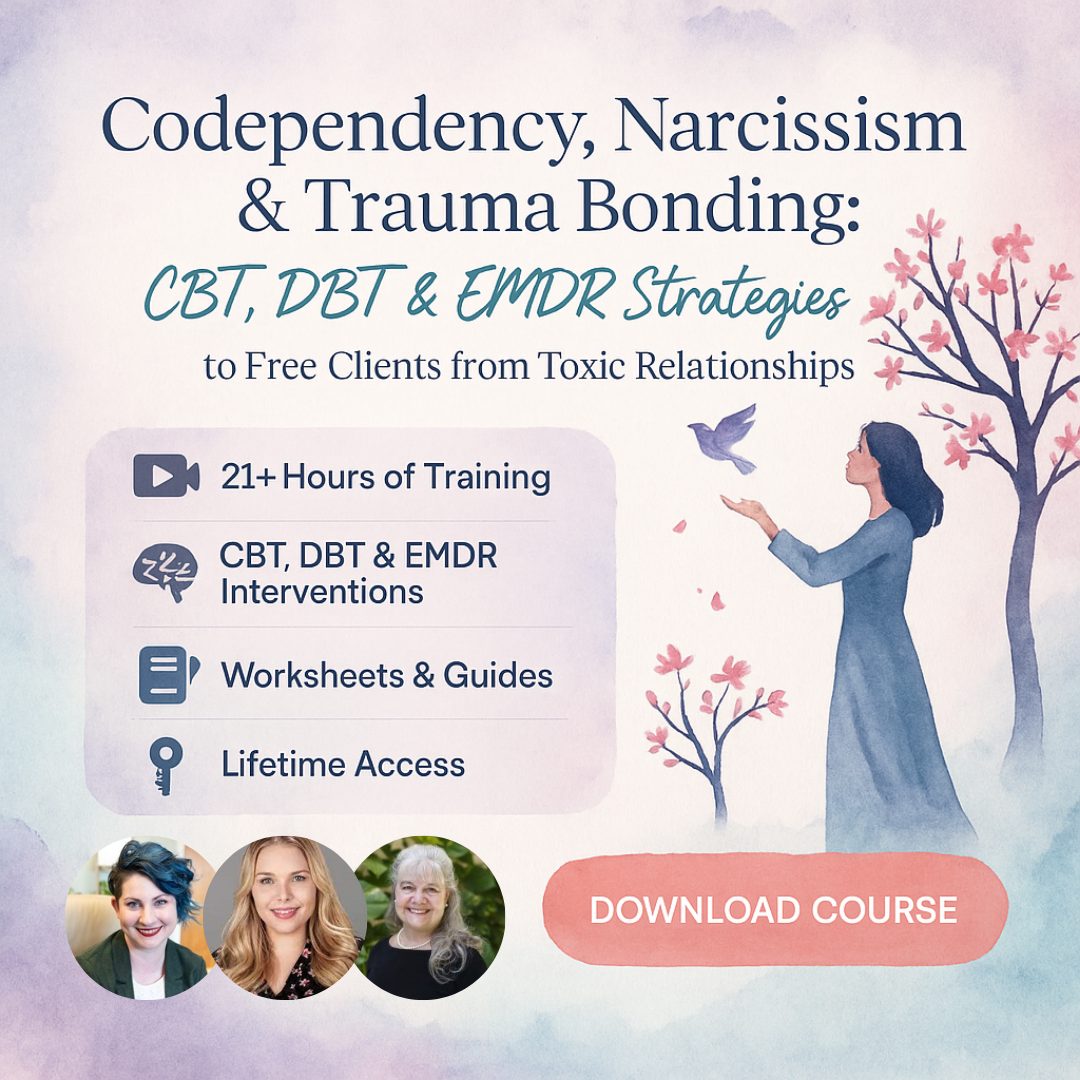


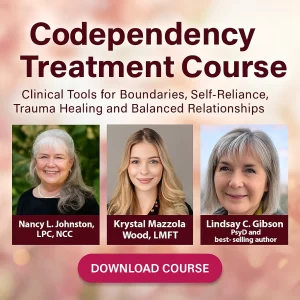
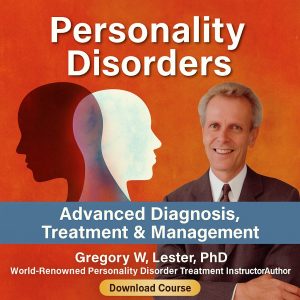
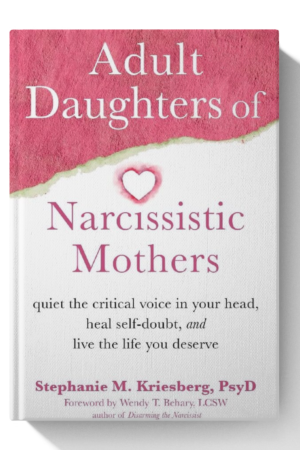
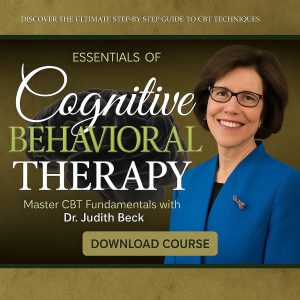


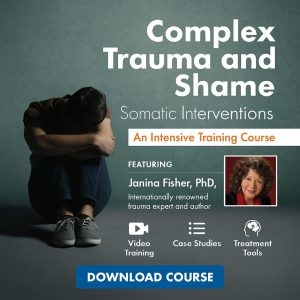
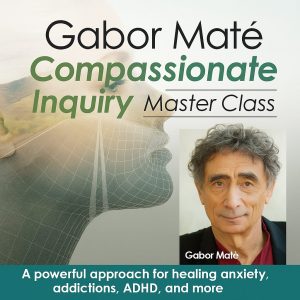
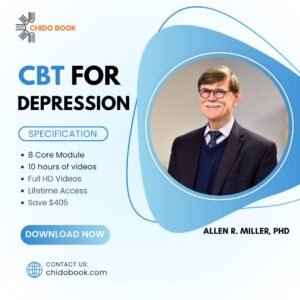
content. The presenters are knowledgeable and approachable, making complex ideas easy to understand. The course’s
focus on both the client and therapist perspective gave it a unique edge. The interventions for grief, shame, and
attachment trauma have already improved my sessions. Overall, this is one of the most comprehensive and valuable
trainings I’ve added to my professional library.
modalities made it feel well-rounded and complete. The sections on distorted reality, gaslighting, and perfectionism
gave me practical ways to identify and address these issues in clients. I also loved the emphasis on helping clients
rediscover their authentic selves. The combination of practical tools and compassionate teaching makes this course
stand out from others I’ve taken. I would highly recommend it.
issues. This course gave me a clear treatment structure to follow, which has boosted my confidence significantly.
The guided scripts for self-visualization and reparenting exercises have been particularly impactful. My clients have
commented on how much lighter and more hopeful they feel after trying these techniques. I also valued the course’s
emphasis on therapist growth and avoiding countertransference pitfalls.
wove together CBT, DBT, EMDR, narrative therapy, and somatic interventions into a cohesive framework. My clients
have especially benefited from the practical boundary-setting strategies. It’s rare to find a course that covers so
many angles of codependency and trauma bonding in such a clear, structured way. I feel much more confident and
effective in my sessions now.
the balance between skills-based interventions like CBT and the deeper trauma-healing strategies from EMDR. The
visualization exercises resonated with my clients, helping them process inner child wounds in a safe and guided way.
The course was well-organized, easy to follow, and provided more content than I expected. It’s an excellent resource
that I know will keep supporting my work for years to come.
The downloadable worksheets are fantastic tools that make therapy sessions more structured and client-focused.
The grief and trauma bonding modules were particularly useful for my work with individuals emerging from long-term
toxic relationships. The presenters are engaging and clearly passionate about their work, which made the training
both enjoyable and educational. It’s a course I know I’ll return to often.
that brought the material to life. It was easy to see how I could apply these strategies directly with my clients.
The modules on radical acceptance and dialectical thinking gave me new language to help clients move through their
healing journey. I also appreciated the course’s focus on therapist self-compassion, which reminded me to model what
I teach. This was an invaluable addition to my professional toolbox.
by evidence-based research. The presenters broke down complicated topics like narcissistic supply and trauma bonding
into digestible lessons. I especially liked the practical tools for addressing distorted thinking and catastrophizing.
My clients are already showing improvements in self-awareness and boundary-setting thanks to these interventions.
This course is both empowering and professionally enriching.
The techniques for regulating the nervous system, such as diaphragmatic breathing and mindfulness, have made a huge
difference in keeping clients present and engaged. The narrative therapy exercises encouraged them to reclaim their
personal power and begin to see themselves beyond the abuse. The added bonus modules on somatic interventions were
equally beneficial. I highly recommend this training for trauma-focused therapists.
healthy boundaries, and the seven types explained in the course were eye-opening. The exercises provided, like broken
record technique and coping ahead, are both simple and powerful. I also loved that the course acknowledged cultural
differences in how assertiveness is perceived. This nuance is critical in practice, and I appreciated the thoughtfulness
of the instructors. A fantastic course overall.
narrative therapy, and even somatic approaches—was incredibly comprehensive. I also appreciated the emphasis on helping
clients avoid recreating codependent dynamics in therapy itself. That was an angle I hadn’t fully considered before,
and it’s already improved how I set boundaries in my sessions. The instructors’ experience really shows, and the content
is explained in a compassionate, non-judgmental way.
into clear phases helped me structure my approach better, especially for clients dealing with complex trauma. The
self-validation techniques and inner child visualizations were particularly effective. My clients reported feeling more
hopeful and less stuck after I introduced some of these exercises. The inclusion of DBT strategies alongside CBT and EMDR
made this training a well-rounded resource. It’s worth every dollar.
information I already know. This course, however, was refreshingly comprehensive and innovative. It covered everything
from CBT interventions for distorted thinking to EMDR practices for trauma healing. I particularly benefited from the
grief-focused sections, as many of my clients struggle with mourning not only the relationship but also the future
they thought they would have. This course gave me new confidence in addressing these issues.
The clarity with which they explained gaslighting, love-bombing, and boundary violations helped me identify these
patterns much more effectively. I loved the practical boundary-building exercises like DEAR MAN and THINK, which
my clients have responded to positively. The speakers bring warmth and years of clinical expertise, which shines
through in each lesson. This is one of the best investments I’ve made in my continuing education.
providing real-world examples and case studies that made the content more relatable. The phase-by-phase treatment model
is especially helpful, as it keeps me organized when working with complex cases. I also valued the attention given to
therapist self-care and awareness, which is often overlooked in other trainings. It feels like this course not only
equips me to help clients but also helps me grow as a professional.
clinical insights but also practical interventions I could take straight to my practice. The sections on narrative therapy
and radical acceptance were particularly valuable, helping my clients reframe their stories and develop healthier coping
mechanisms. The downloadable worksheets are simple yet effective, and my clients appreciate the tangible tools. Having
lifetime access means I can revisit modules whenever I need a refresher, which is a huge bonus. Highly recommended!
manipulation, and I previously struggled to guide them out of it effectively. The structured phases in this training,
from building awareness to teaching intimacy and boundary skills, gave me a clear roadmap. The additional EMDR exercises
like safe place and butterfly hug have already proven useful in session. The content is explained in a practical,
non-intimidating way, which made it easy to start applying techniques immediately. This is a must-have for anyone working
with trauma or toxic relationships.